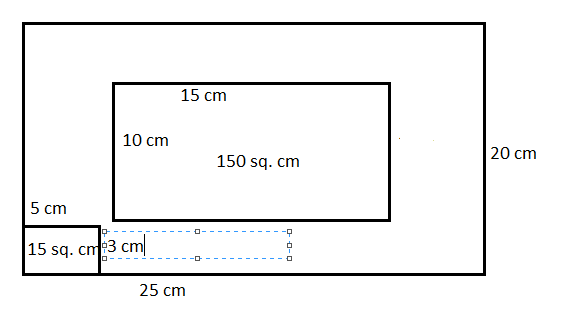Engage NY Eureka Math 4th Grade Module 7 Lesson 16 Answer Key
Eureka Math Grade 4 Module 7 Lesson 16 Problem Set Answer Key
Work with your partner to create each floor plan on a separate piece of paper, as described below.
You should use a protractor and a ruler to create each floor plan and be sure each rectangle you create has two sets of parallel lines and four right angles.
Be sure to label each part of your model with the correct measurement.
Question 1.
The bedroom in Samantha’s dollhouse is a rectangle 26 centimetres long and 15 centimetres wide. It has a rectangular bed that is 9 centimetres long and 6 centimetres wide. The two dressers in the room are each 2 centimetres wide. One measures 7 centimetres long, and the other measures 4 centimetres long. Create a floor plan of the bedroom containing the bed and dressers. Find the area of the open floor space in the bedroom after the furniture is in place.
Answer:

Total area = length x width
= 26 x 15
= 390 sq. cm.
Bedroom + dresser + dresser =
54 + 14 +14 = 76 sq. cm.
Now, Room furniture =
390 – 76 = 314 sq. cm.
Therefore, The area of the open floor space in the bedroom after furniture is placed = 314 sq. cm.
Question 2.
A model of a rectangular pool is 15 centimeters long and 10 centimeters wide. The walkway around the pool is 5 centimeters wider than the pool on each of the four sides. In one section of the walkway, there is a flowerbed that is 3 centimeters by 5 centimeters. Create a diagram of the pool area with the surrounding walkway and flowerbed. Find the area of the open walkway around the pool.
Answer:

Total area = 25 x 20 = 500 sq. cm
Pool + flower bed =
150 + 15 = 165 sq. cm.
Total area = 500 – 165 = 335 sq. cm.
Therefore, The area of the open walkway around the pool = 335 sq. cm.
Eureka Math Grade 4 Module 7 Lesson 16 Reflection Answer Key
In the table below are skills that you learned in Grade 4 and that you used to complete today’s lesson. These skills were originally introduced in earlier grades, and you will continue to work on them as you go on to later grades. Choose three topics from the chart, and explain how you think you might build on and use them in Grade 5.
| Multiply 2-digit by 2-digit numbers |
Use the area formula to find the area of composite figures |
Create composite figures from a set of specifications |
| Subtract multi-digit numbers | Add multi-digit numbers | Solve multi-step word problems |
| Construct parallel and perpendicular lines | Measure and construct 90° angles |
Measure in centimeters |
Eureka Math Grade 4 Module 7 Lesson 16 Homework Answer Key
For homework, complete the top portion of each page. This will become an answer key for you to refer to when completing the bottom portion as a mini-personal white board activity during the summer.
Use a ruler and protractor to create and shade a figure according to the directions. Then, find the area of the unshaded part of the figure.
Question 1.
Draw a rectangle that is 18 cm long and 6 cm wide. Inside the rectangle, draw a smaller rectangle that is 8 cm long and 4 cm wide. Inside the smaller rectangle, draw a square that has a side length of 3 cm. Shade in the smaller rectangle, but leave the square unshaded. Find the area of the unshaded space.
Answer:

The area of unshaded part =
( 4 x 8 ) – ( 3 x 3 )
32 – 9
= 23 sq. cm
Therefore, the area of unshaded part = 23 sq. cm.
Question 2.
Emanuel’s science project display board is 42 inches long and 48 inches wide. He put a 6-inch border around the edge inside the board and placed a title in the center of the board that is 22 inches long and 6 inches wide. How many square inches of open space does Emanuel have left on his board?
Answer:

The square inches of open space Emanuel have left on his board.
(42 x 48)-{(6 x 42)+(6 x 42)+(6 x 32 )+( 6 x 32 ) + (6 x 22)}
= 2016 – { 252 + 252 + 216 + 216+ 132 }
= 2016 – 1068
= 948 sq. inches.
Challenge: Replace the given dimensions with different measurements, and solve again.